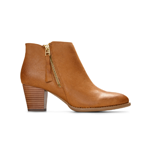
What Causes Bunions?

Written by: Dr. Jackie Sutera
Bunion symptoms can be immensely painful. And when they don’t hurt, they may lead to another foot problem, like blisters, corns, calluses, infected ingrown toenails, and hammertoes. What’s more, the foot deformity can make most shoes feel overly tight and uncomfortable.
But what causes bunions in the first place? The footwear pros at Vionic are here to break it down for you and provide insight to available orthotics to alleviate some of the common symptoms. Let’s get started.
What Are Bunions?
A bunion (hallux valgus) is a bony bump that develops on the base of the big toes.¹ They happen when upper foot bones move out of place, which causes the top of the big toe to pull toward the smaller ones. In turn, the joint at the base of the toe protrudes out in the opposite direction. “Bunions can be hereditary and tend to run in families, but some shoes, injuries, and activities over time can encourage and expedite formation”, says Dr. Jackie Sutera, Vionic Innovation Lab member and podiatrist.
The bony protrusion is typically obvious, as the bulge juts out and is often inflamed. Discomforts associated with bunions range from redness and mild soreness to swelling, persistent tenderness, and severe foot pain. Some people also have a difficult time moving their toes.
What Are Bunionettes?
A bunionette or Taylor’s bunion is essentially a smaller form of a bunion. It develops at the base of the baby toe and is thought to often be a result of sitting cross-legged for hours on end in tight-fitting shoes. But don’t let the cute name fool you—bunionettes can be extremely painful. “Bunionettes cause the forefoot, in essence, to become wider and should be accommodated with proper fitting shoes. Symptoms like swelling, pain, redness, and inflammation can also present, just like bunions that form at the great toe joint”, says Dr. Sutera.
What Are Adolescent Bunions?
While bunions are most often seen in adults, children and teens can get them too. Adolescent bunions usually affect girls between 10 to 15 years old, though boys can develop them as well.² Occurring on one or both feet, the condition can be painful or relatively painless. And unlike adult bunions, children and teens are typically still able to move their big toe joint.
The medical community isn’t sure what’s behind adolescent bunions or why girls are more likely to have them than boys. However, some believe it’s related to growing feet and changes in footwear during their pre-teen and early teenage years. If your child has bunions, we recommend talking to a podiatrist about ways to prevent the foot deformity from progressing.
What Causes Bunions to Form?
What causes bunions on feet? The exact cause of the foot deformity is unknown, but most experts agree on a few potential factors. This includes foot stress, genetics, foot deformities, and certain medical conditions. Here’s what you should know.

Foot Stress
Sore feet causes foot stress and can be a result of overuse, ill-fitting shoes, or both. For instance, if you’re on your feet all day at work and aren’t wearing proper footwear, the persistent pressure on the structure of your foot can affect its shape over time.
Additionally, athletes sometimes develop deformities from overuse, though they’re more likely to wear specialized shoes. While bunion formation develops slowly, often over the course of years, suffering a foot injury might contribute to the issue.
Whether it’s a broken bone or an ankle sprain, people tend to put extra weight on other body parts to keep pressure off the foot injury. This overcompensation may lead to foot-related issues, like a bunion development.
Genetics
Bunions are very rarely something people are born with, though some may be predisposed to developing the deformity later in life. If a close relative has bunions or another foot structure condition that ended up causing a bony protrusion, you could inherit a foot type with a higher chance of getting them.³
Foot Deformities
Some foot deformities are congenital, meaning they’re present at birth. A person can be born with pronated feet, club feet, and flat feet (though you can also develop fallen arches later on). These deformities might make someone more inclined to get a bunion in adolescence or adulthood. Wondering what is pronation? Our experts at Vionic are here to guide you through common foot concerns including what the difference is between overpronation vs underpronation and how to correct overpronation. You’ve got questions and we’ve got answers!
Medical Conditions
Certain inflammatory diseases, such as rheumatoid arthritis (RA), osteoarthritis, and psoriatic arthritis, can affect joints throughout the entire body, including the feet. These disorders are sometimes associated with the development of bunions.
Why Do I Have Bunions?
It’s hard to say exactly why an individual has bunions. It could be a result of foot stress, injury, genetics, another foot deformity, a medical condition, or a combination of factors. Some think tight-fitting footwear is a culprit, while others believe it may only exacerbate an existing issue.
If you consider the very structure of a bunion—how the big toe pivots toward the others from the top and juts out at the bottom—it makes sense that certain shoes could be a potential cause.
Aside from tight-fitting shoes, pointed styles and pumps with narrow toe boxes tend to squeeze and overcrowd the toes. Wearing shoes like this once in a while might not be enough to create a deformity. But day after day, year after year, cramming your toes into a specific shape could have a lasting effect.
How to Know If You Have Bunions
As we mentioned, the protruding bumps are typically obvious. “I recommend a visit to your podiatrist for X Rays, which will confirm if you have a bunion. This will also allow your doctor to evaluate the severity and recommend a proper individualized treatment plan.”, advises Dr. Sutera . However, there are a few other signs indicating a person has bunions.
Symptoms of bunions include:
- Swelling at the base (bottom joint) of the big toe
- Redness at the base of the big toe
- A sore, persistently tender bump on one or both feet
- Corns and calluses between the toes
- Limited movement or inability to move the big toe
- Trouble fitting into shoes
- Pain when walking or standing
Aside from the bulging bump, these symptoms are associated with other medical conditions and foot deformities, so you may want to see a specialist to be sure.
Should I See a Podiatrist for Bunions?
If you’re experiencing ongoing pain and are unable to move your big toe or flex your foot, it’s probably best to check in with a medical professional, like a podiatrist (foot doctor) or an orthopedic foot specialist.
Though most bunions don’t require medical treatment, your provider might suggest prescription orthotics or over-the-counter shoe inserts. They can make recommendations about footwear and lifestyle changes as well.
How Are Bunions Diagnosed?
A podiatrist or orthopedist will most likely be able to tell that you have a bunion simply by looking at your foot. Having said that, there’s a good chance they’ll take an X-ray to check for joint damage. The imaging can also give them clues as to what may have caused it.
How Are Bunions Treated?
You may be wondering, can bunions be reversed? Unfortunately, the only way to get rid of a bunion entirely is through surgery, which involves either removing the bump or cutting and realigning the joint.⁴ However, there are various treatments and lifestyle changes that can help you manage bunion pain and prevent the deformity from getting worse.⁵
Treating and managing bunions can involve:
- Over-the-counter bunion pads to cushion the bump
- Medical tape to help align the toe joints
- Custom-made or over-the-counter orthotic shoe inserts
- Physical therapy and massage to break up the soft tissue and encourage toe mobility
- Stretching and strengthening moves for the toes
- Over-the-counter NSAIDs (nonsteroidal anti-inflammatory drugs) like aspirin and ibuprofen to reduce inflammation, swelling, and pain
- Icing and elevating the feet
- Switching to wider, more supportive footwear
For lots of folks, footwear changes are the first and most effective course of action. There’s a good chance your podiatrists will recommend switching out your shoes before suggesting other medical interventions.

The Best Shoes for Bunions
Properly fitting footwear is crucial in preventing bunions from forming and stopping an existing protrusion from getting worse. Learn how to measure your shoe size in terms of both length and width to ensure a perfect fit every time.
Here at Vionic, we design some of the best shoes for bunions, including wide widths and styles with adjustable uppers. Each pair is biomechanically engineered with built-in orthotics. You can count on arch support, roomy toe boxes, and durable, shock-absorbing outsoles that take pressure off your joints.
In addition to dress shoes, boots, slippers, flats, wedges, and sneakers, Vionic carries an impressive collection of fashion-forward orthotic sandals for bunions. We also offer orthotics for men and women, which can go in virtually any closed-toe shoe in place of factory inserts.
Order yours today!
External sources:
- “Bunions”. Mayo Clinic. https://www.mayoclinic.org/diseases-conditions/bunions/symptoms-causes/syc-20354799
- “Bunions”. Boston Children’s Hospital. https://www.childrenshospital.org/conditions-and-treatments/conditions/b/bunions
- “Bunions (Hallux Valgus)”. Cleveland Clinic. https://my.clevelandclinic.org/health/diseases/14386-bunions-hallux-valgus
- “Bunion Surgery”. Johns Hopkins Medicine. https://www.hopkinsmedicine.org/health/treatment-tests-and-therapies/bunion-surgery
- “Minimize, Manage, and Prevent Bunions”. Healthline. Updated on March 8, 2019, https://www.healthline.com/health/how-to-get-rid-of-bunions#15-tips
- Jen McCaffery and Tiffany Ayuda. “18 Best Shoes for Bunions to Buy in 2021, According to Podiatrists”. Prevention. Aug 23, 2021, https://www.prevention.com/beauty/style/g19599046/best-shoes-for-bunions/










